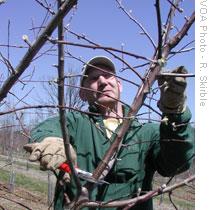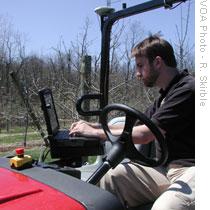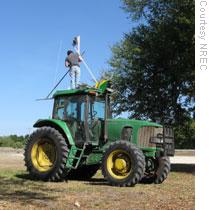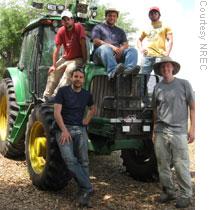News Features Interactive Shows Web Services
|
|
Robots Spread Seeds of Change in Fruit Orchards
|
By Rosanne Skirble
Washington, D.C.
01 May 2009
|
|
Mechanization has made the modern farmer's life a lot easier. That's
especially true for those who grow crops like wheat, soy or corn on
big, broad fields. But the story is quite different for growers who
raise fruit, nuts, vegetables or nursery plants.
These so-called -
a $45-billion-a-year business in the United States - require intensive
hand labor. Faced with rising labor costs, a shortage of workers and
increasing demand for safe and affordable products, specialty growers
are desperate for ways to boost food quality without boosting its
price.
 | | Half Crown Hill Orchard's owner Craig Senovich does some early spring pruning |
One answer, says Craig Senovhich, may be robotic
technology. Senovich, an engineer by day, opened four years ago
in an overgrown field on land that his great-grandfather used to farm
vegetables.
"There were a lot of crab apple trees and brush, and
it took us several months just of digging out trees and clearing the
land and preparing the soil," he says.
Senovich fenced in a
1.2-hectare plot, planted 1,300 trees and installed a drip irrigation
system. Field sensors and a weather station are linked to his personal
computer and track data related to the crop's well-being.
Half
of Crown Hill Orchard is also a robotic technology test site for a
project looking at ways
of mechanizing the production of specialty crops like apples.
 | | Carnegie Mellon University Research Programmer Brad Hamner gives computer instructions to an autonomous electric vehicle at Half Crown Hill Orchard |
"It
would be nice to be able to have some automated stuff just to mow the
lawn," he says, reflecting on a chore that takes him several hours.
, a Carnegie Mellon University robotics professor and principal
investigator on the USDA project, says that task would be easy. He's
at the orchard testing a battery-powered electric utility vehicle that
drives itself. A laptop computer is the only passanger. Two laser
scanners mounted on the front bumper, each taking 13,000 measurements
per second, help plot its course.
"It sends the command to a controller on the vehicle, and that adjusts the steering and speed," says Singh.
On this day, the robotics team explores how the unmanned vehicle gets around.
 | | Matt Swanson, a graduate student at Carnegie Mellon University's National Robotics Engineering Center, sets up yield estimation sensors on one of the tractors at Southern Gardens Citrus in Florida |
"This
technology coupled with sensors already available might give farmers a
lot more information," says Singh, who envisions its application would
allow growers to monitor more frequently.
Another USDA applied
robotics project takes Cris Dima to Florida. The southeastern U.S.
state is second only to Brazil in citrus production worldwide. Dima is
a scientist at the at Carnegie Mellon, and he has just
spent several weeks in one of the state's largest orange groves testing
a network of autonomous, or driverless, tractors. He says the farm
could be monitored virtually from an office or from somewhere in the
field.
"Four or more autonomous tractors could run simultaneously and perform operations such as spraying or mowing."
Robots
could also be engineered to administer precise amounts of water or
chemicals to specific trees. Dima says the goal is not to develop an
entirely autonomous operation, but rather to integrate technology the
farmer needs at an affordable price.
"Beyond proving that this
is possible, there is work to be done in reducing the cost of the
technology, making it robust and transferring it to somebody who can
commercialize it."
 | Researchers taking part in the March 2009 field experiments at Southern Gardens Citrus grove in Florida. Chris Dima is in the front on the left
|
Back at Half Crown Hill Orchard, Sanjiv Singh
says it's going to take growers like Craig Senovich, engaged in the
process, to move this technology into the marketplace.
"We've
been working on this robotics [automation] technology for 25 years, and
from a technology perspective, some of the things are well in hand."
The challenge, he adds, is to develop technology that can help generate enough money for growers.
Senovich
nods in agreement as he watches the electric vehicle drive itself
safely down rows of budding trees in his orchard. He's hoping these
test runs will soon advance to the next step and start providing fruit
and vegetable growers with some automated and money-saving solutions.
Comments:
Be the first to submit a comment.
Send Us Your Comments
Submit your comments about this article so we can post them on our website. Note: We will not publish your E-mail address.
By using this form you agree to the following: All comments will be reviewed before posting. Be aware - not all submissions will be posted. VOA has the right to use your comments worldwide in any VOA produced media. Terms & Conditions.
|
|
|